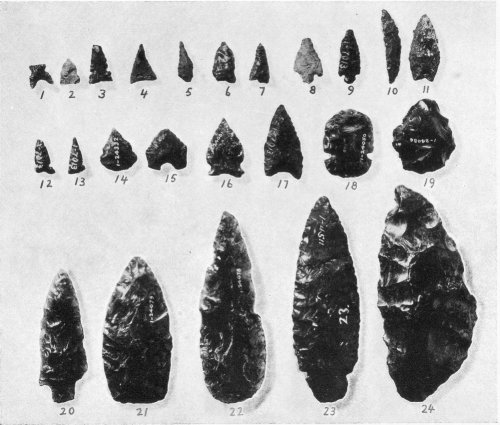
[click to enlarge]
| Online Library: | Title | Author | California | Geology | History | Indians | Muir | Mountaineering | Nature | Management |
Yosemite > Library > Miwok Material Culture > Chipped Stone Implements >
Next: Arrow Straighteners & Smoothers • Contents • Previous: Steatite
The scant information concerning points and blades of flint and obsidian was probably due to the sudden influx of steel implements sweeping them out of use by 1850. However, a few flint and obsidian pieces have been collected at aboriginal sites in the Sierra Nevada. There is reason to believe that these objects are of Miwok origin. They are illustrated in plate XXXVII. The wealth of flint and obsidian implements from the Plains Miwok territory is described and figured by Schenck and Dawson.
The simplest stone knife was a naturally fractured stone, unworked, such as was used to hack off hazel branches or to cut off maple shoots. A flake of gray “flint” (kolubu, C), unworked, was used to scrape split maple shoots for basketry, and a similar black obsidian flake to scrape down a bow. Luka (C) is the term for a scraper, applied also to steel blades so used. The stone flakes were struck from a core.
A knife (kike, C) of obsidian (sītcan, P; sītcánû, N; pasakka, C) would appear to have been a worked implement. Flint (hágü, P, N; sitikwina, C) and jasper appear not to have been used for knives, except among the Southern Miwok. Mr. W. H. Edwards of Vacaville, California, has a large number of flint blades and points collected from an archaeological site at Merced Falls in Southern Miwok territory. Probably some of these were knives.
A stone saw was used to cut abalone shell, but perhaps it was more in the nature of a file than a saw. The Field Museum of Natural History has an obsidian flake (70183), with greatest dimension twenty-seven millimeters, which was used at Groveland as a scarifier, in sickness and grief.
What is labeled as a hide scraper of chert, from Tuolumne, in Central Miwok territory, is in the Field Museum collection (70180). There are two other Central Miwok examples from Sonora (70161, 70162), both flattish, oval stones, and one of chalcedony from Tuolumne (70163).
A crude, though probably effective, spear was made by binding with sinew a large obsidian or flint spearhead to the end of a smooth mountain mahogany pole about seven feet long. The chief use of the spear was in war. Whether this is the hotca (C) spear described under “Taking of Fishes” is not clear.
In the Field Museum of Natural History there is a six-foot spear (70266) with a brown flint point. The point is a broad equilateral triangle, 30 mm. wide, lashed to the shaft with sinew and some adhesive, perhaps pine pitch. The handle is of hard wood. The basal end of the handle is somewhat pointed, apparently with a steel tool.

[click to enlarge] |
Obsidian and Flint Points.
Figure 1. Basal portion of arrow point. Excavated just northeast of Mineral Station, about five miles cast of Mokelumne Hill, Calaveras County. Spec. No. 1-10509.
Figures 2-4. Obsidian points. Yosemite Valley. Spec. No. 1-7013.
Figure 5. Flint point. (Location same as 1.) Spec. No. 1-10509.
Figures 6, 7. Obsidian points. Big Meadow, Coulterville road, Yosemite National Park. Spec. No. 1-24083, 1-24084.
Figure 8. Flint point. (Location same as 1.) Spec. No. 1-10509.
Figure 9. Obsidian point. Yosemite Valley. Spec. No. 1-7013.
Figure 10. Obsidian point. (Location same as 6, 7.) Spec. No. 1-24085.
Figure 11. Reddish flint point. From site of Eyeyaku, near Tuolumne. Spec. No. 1-24331.
Figures 12, 13. Obsidian points. Yosemite Valley. Spec. No. 1-7013.
Figure 14. Obsidian point. (Location same as 11.) Spec. No. 1-24332.
Figure 15. Obsidian point. (Location same as 9.) Spec. No. 1-7013.
Figure 16. Obsidian point. (Location same as 6, 7.) Spec. No. 1-24081.
Figure 17. Obsidian point. (Location same as 9.) Spec. No. 1-7013.
Figure 18. Basal portion of obsidian blade. (Location same as 6, 7.) Spec. No. 1-24080.
Figure 19. Obsidian flake. (Location same as 6, 7.) Spec. No. 1-24086.
Figure 20. Obsidian blade. Near top of S-turn, Big Oak Flat Road, at 4900 feet elevation, Yosemite Valley. Spec. No. 1-18584.
Figure 21. Obsidian blade. (Location same as 6, 7.) Length 85 mm. Spec. No. 1-24079.
Figure 22. Obsidian blade. (Location same as 6, 7.) Spec. No. 1-24078.
Figure 23. Obsidian blade. Horse Shoe Bend, Merced River, Mariposa County. Spec. No. 1-4511.
Figure 24. Obsidian blade. (Location same as 6, 7.) Spec. No. 1-24077.
Neg. No. 8275.
Next: Arrow Straighteners & Smoothers • Contents • Previous: Steatite
| Online Library: | Title | Author | California | Geology | History | Indians | Muir | Mountaineering | Nature | Management |
http://www.yosemite.ca.us/library/miwok_material_culture/chipped_stone_implements.html